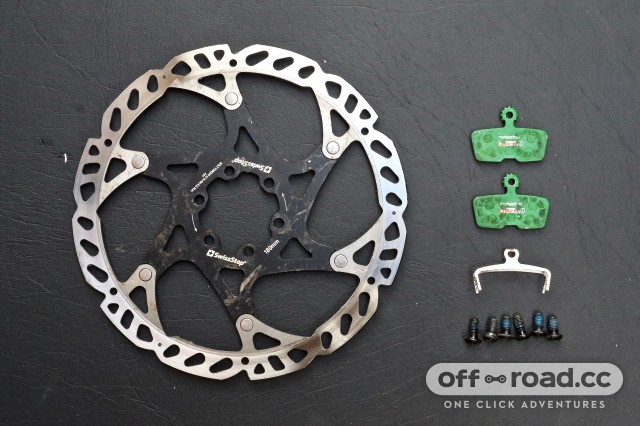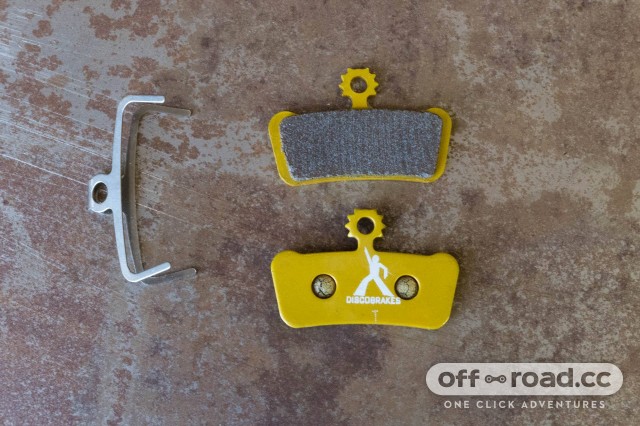When it comes to replacing your disc restriction pads, there are a staggering number of different brands and types to choice from. Our guide will run you through what you need to know, roofing sintered and organic pad compounds and their relative strengths and weaknesses so you tin can get the best disc pads for your needs.
[Updated 21st June 2021]
When it comes to replacing your disc restriction pads, the showtime matter you need to practise is brand sure you get the correct fitment for your brakes. At that place are a dizzying number of unlike styles available, so don't call up that all Shimano or SRAM brakes will use the aforementioned pad - they don't. For instance, in that location are numerous dissimilar pads for Shimano XT brakes, depending on which year they were fabricated.
How practise I know which pads I need?
If you know the exact model and year of your brakes, and so this is a practiced starting point, but the best way to know if new ones will fit to remove the old ones and visually compare them - yous're going to have to exercise this anyway if they're worn out, then it's no great hardship.
How to remove disc brake pads
To remove the pads, kickoff, remove the wheel and then clean the calliper with disc restriction cleaner and so wipe it clean with a clean rag or tissues. You will then demand to button the pistons back - worn pads are thinner than new ones, and hydraulic systems automatically push them out to recoup. Skip this step, and yous'll struggle to get the disc and wheel back in with the new pads.
There are specific tools for pushing pads dorsum , and some multitools will have something too, just using a large, flat-bladed screwdriver or tyre lever advisedly achieves the same thing. Popular it in between the pads where the disc would sit and gently lever them back until they go no further. You'll need to adjust either cable tension or a pad advance adjuster on cable systems, depending on the model.
Almost disc brake pads are secured in identify past a pin that sits through a hole in both pads, oftentimes with a retaining clip on one finish to foreclose them from falling out. Remove that and then unscrew or otherwise remove the pivot. Make sure yous don't lose these, as aftermarket pads often come without them.
Now'south a good fourth dimension to inspect the pads y'all're taken out too - if they're non evenly worn across the pad, and then your calliper is out of alignment, and if i side is more than worn than the other, then you accept a gluey piston. Both of those issues will need fixing before you stick some new pads in.
Suppose they've worn down to the metal backing pad. In that example, yous should carefully check your rotor for scoring damage - and if they've worn through the backing pad as well, and then shame on you lot for non noticing. It'd be wise to inspect the pistons for damage too. If you lot've been through lots of pads on the same rotor, cheque that the rotor isn't excessively thin. Check the manufacturer'south guidelines on minimum thicknesses.
What do the different pad compounds mean?
All pads are made by mixing various powdered additives with a binding agent and then squashing information technology all together at high estrus and force per unit area to form a solid cake on the backing pad. What's in the mix of powders has a drastic effect on the pad's properties. At that place are iii main types of disc restriction pad chemical compound for bikes.
Organic
Also commonly known asresin pads, these are the usual fitment on well-nigh new bikes. These brake pads are made from not-metallic additives such every bit safety, glass, carbon and Kevlar to provide an accommodating pad that works merely isn't very durable nether hard use.
| PROS | CONS |
| Excellent seize with teeth from cold | Friction decreases at high pad temperatures |
| Very little braking noise | Pads wear apace |
| Slow rotor article of clothing | |
Sintered
Also known as metallic brake pads, these use a very high proportion of metallic fillers such as copper, steel and iron. They're made for work all-time nether farthermost use status, and so ofttimes aren't the best choice for general riding.
| PROS | CONS |
| Potent, constructive braking at high pad temperatures | Can be noisy |
| Wearisome pad wear rate fifty-fifty in poor conditions | Poor bite when cold - need to be hot to work well |
| Metal content can transfer more rut into the calliper, potentially overheating the fluid |
| Faster rotor wear |
Semi-metallic
Every bit the name suggests, these take metallic fillers mixed with organic fillers to requite a balance of the qualities of each. They're a fleck of a Goldilocks option, and so they're suitable for anyone that wants increased hard-utilize performance over an organic pad without the drawbacks of a sintered pad. But, on the flip side, they retain some of the drawbacks of each, too.
| PROS | CONS |
| Better high-temperature functioning than organic pads | Limerick - and performance - can vary wildly from brand to make |
| Less noisy than sintered pads | Don't have the same ultimate high-temperature performance every bit sintered pads |
| Decent bite from cold | Noisier than organic pads |
So which brake pads are best?
As with many things in life, it really comes downwardly to what sort of riding you do and where you lot'll be willing to compromise.
If you live somewhere flatter or just don't throw yourself down huge descents all that often, at that place'southward nothing wrong with an organic pad. They'll provide strong braking from the moment you lot pull the lever while beingness tranquillity and often cheaper than the other options too.
If you often ride long, sustained descents with lots of braking or ride somewhere gritty and wet and wearable out pads regularly, then sintered pads are a wise pick. If Yous don't heed the noise, they're powerful and have plenty of bite once they're warm and last for a long time.
Semi-metallic pads are an first-class compromise, with a decent seize with teeth from cold, respectable high-temperature performance and good wear characteristics.
Of form, nothing is stopping you from mixing and matching brake pads front to rear to adapt your needs. Rear brakes tend to be dragged more than while having a good initial bite at the front is always confidence-inspiring. A sintered pad at the rear paired with a semi-metallic compound in the front tin offer a expert blend of functioning, fifty-fifty semi-metallic at the rear and organic at the forepart.
Merely what near finned restriction pads?
Shimano introduced their Water ice-Tech restriction pads in 2015. These accept a backing plate with a finned heat sink that protrudes from the summit of the calliper. It's claimed to improve performance as the rut generated under braking is prodigal by airflow more quickly, resulting in lower temperatures at the braking surface and calliper body, giving a consistent operation.
Initially, these pads were only available for specific Shimano brakes, but several aftermarket manufacturers have taken the idea and applied it to pads for other brands. Superstar Components , Uberbike Components , Swiss End and some others all accept designs like this. While some take laboratory testing to dorsum upwards their claims of cooler running, about do not, so information technology'southward worth taking these claims with a pinch of table salt - specially as they're a fair bit more expensive than standard pads.
You lot might as well like:


